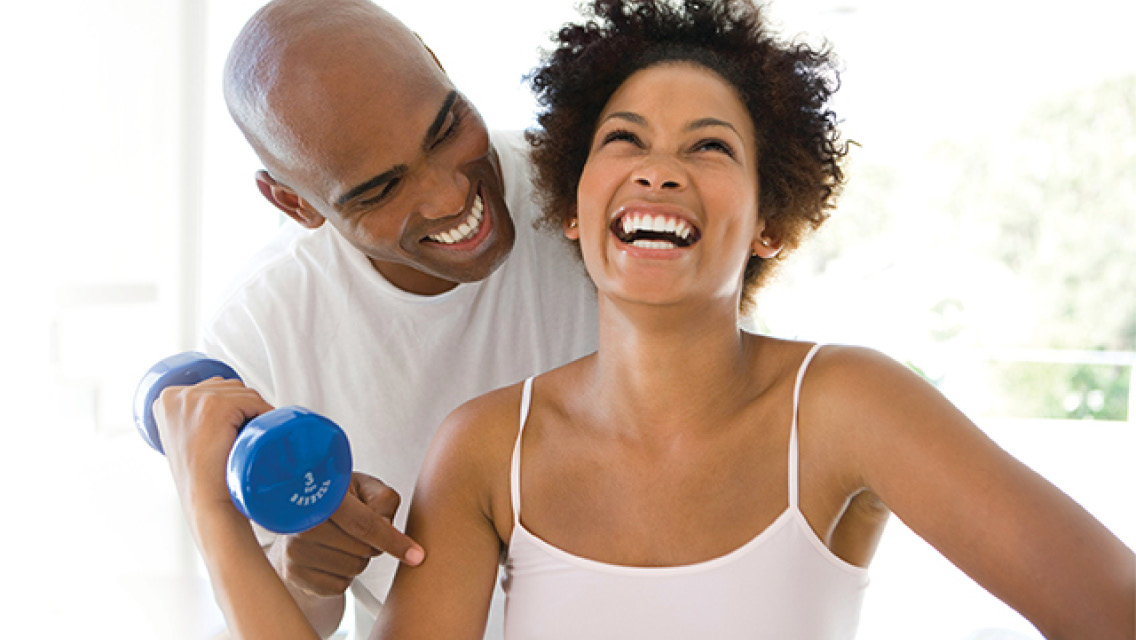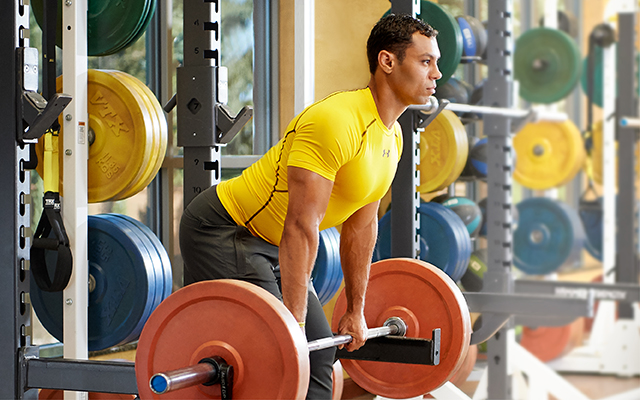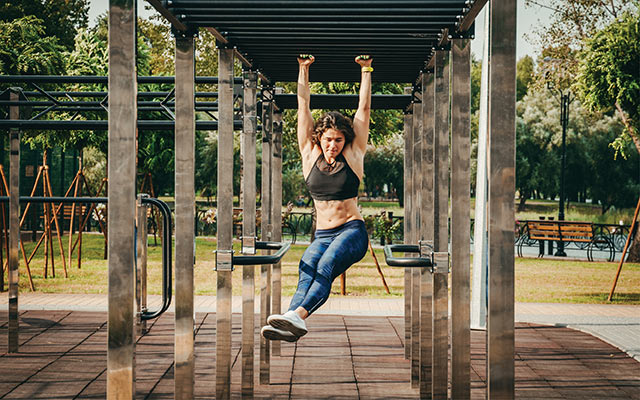Hey guys, remember those good old bachelor days? When “responsibility” was just a word used by people who looked like your parents? When you were at your best physically, even though your personal habits were at their worst? When the only person you had to answer to or for was yourself? Yep, back then you had it made.
Then came the inevitabilities of age. Your body got a little heavier, your muscles felt a little softer, and it wasn’t quite as easy to recover from that occasional late-night splurge or weekend basketball game. Next, the responsibilities of marriage, fatherhood and a career arrived. All of which conspired to make regular trips to the gym and runs around the park seem like luxuries.
“Reaching middle age for most men means their life has completely evolved from what it once was, especially if they’re on the career track and in a committed relationship,” says Lawrence Schwartz, author of Fat Daddy/Fit Daddy. “Longer work days, raising children and working toward a stronger marriage leave most men with little or no time to exercise.”
What’s more, after turning 30, the typical male starts to lose an average of 10 to 16 ounces of lean body mass [muscle tissue] a year, according to Jeff Bell, director of continuing education of Spectrum Wellness in Manhattan, N.Y. “At the same time,” he says, “your metabolism also begins to slow down, causing your body to gain 1 pound of fat annually.”
Not what you wanted to hear?
Then listen to this: Looking and feeling like you did during your bachelor days can be done. It’s just going to take a bit more effort and some newfound dedication. Chances are, you already knew that. What you might not have considered, though, is that regular exercise can actually improve every aspect of your life, from the way you raise your kids, to how you perform at work, to how well you maintain a happy marriage. So, hey, if you can’t seem to “just do it” for yourself, then …
Do It for Your Kids
If you have children, or are planning to, staying in tip-top shape is essential – and not just because you’ll need more juice to keep up with the youngsters. If you take better care of yourself, it will improve and increase the quality of the time you spend with your family. There’s also a good chance that if you have a healthier lifestyle, your kids will enjoy a healthier future.
“Maintaining good health habits means your children will most likely grow up incorporating those same choices into their own lives as well,” Schwartz says. Between the ages of 1 and 10, kids are like sponges, he notes. They not only absorb everything you teach them, they learn countless lessons indirectly by simply watching you navigate the day-to-day. “If they see you leading an active lifestyle, chances are they’ll pick up the same habits in an attempt to emulate you,” observes Schwartz.
If you are fit, you’ll also be more apt to participate in many of the games and activities that interest your kids, which helps establish and enhance a long-term paternal bond. Spending quality time in this way, whether it’s a walk in the park or a game of touch football, also lessens the odds that you or your kids will turn to TV, video games or other sedentary forms of entertainment.
Finally, don’t think that your peers are the only ones who notice when you let yourself go. Kids are tough critics of one another, and having unhealthy parents can lead to unwanted social anxiety. “For some parents, being out of shape can indirectly affect how their children are treated by their peers,” says Schwartz. “Kids can be cruel, and the fact is, if you’re significantly overweight, it could get your kids picked on.”
Ultimately, of course, kids will find a way to cope with this sort of teasing. But, as Schwartz points out, you might not like the way they choose to avoid the problem: “Your kids may be shying away from opportunities to bond with you, not because they are necessarily embarrassed, but because they want to avoid conflicts in school that you may be unaware of.”
Do It for Your Sweetheart
Your partner may love you for better or worse, but staying in great shape is a surefire way to keep your marriage robust enough to manage the inevitable challenges of long-term commitment. Greater muscle tone and less body fat will not only make you more attractive, it will also boost your self-confidence – another turn-on.
When you are in better shape, you snore less. When you are eating clean, you smell better. And when you’re confident in your own body, you’ll be more tuned into your partner’s.
Exercise also keeps your sex life moving forward by improving the chances that certain body parts won’t end up going in reverse. Testosterone (the male hormone responsible for maintaining a man’s sex drive) begins to ebb in most men in their late 20s. “Regular exercise can raise blood testosterone levels in your body, as well as increase how much oxygen your body is able to use for energy,” says Heather Dillinger, an AFAA (Aerobic and Fitness Association of America) certification specialist and elite-level personal fitness trainer in Alexandria, Va.
“The combined effect can make a huge difference in boosting your libido.” Research performed at the Harvard School of Public Health found that men who ran at least three hours a week had a 30 percent lower risk of impotence than sedentary men. Even if you’re not a runner, “just adding 20 to 30 minutes of light aerobic activity, such as walking, can make an impact on what you inevitably bring to the bedroom,” says Dillinger.
As is the case with any successful romantic relationship, it’s not just about how you look or perform sexually; it’s about sharing the joys of everyday life. “Clearly, being in shape can help a man be more sexually athletic and more experimental in bed,” observes Ian Kerner, PhD, a clinical sexologist and author of She Comes First. “But having stronger muscles and increased flexibility can help outside of the bedroom as well.”
Over time, many couples end up doing fewer things together because they are out of shape, which limits activity. Fit couples are more apt to play tennis, golf, go on bike rides or just take long walks around their neighborhood; the very sorts of activities that help maintain connectedness and lead to greater intimacy. “The end result is an emotional relationship that always feels like it’s growing instead of seeming stagnant and routine,” says Kerner.
Working out diminishes stress, too, which means fewer spousal spats. “Even when relationship woes creep in, staying in shape can lower your stress levels naturally,” Kerner concludes.
Do It for Your Job
“Being out of shape makes it harder for others to take you seriously because you’re perceived as someone who can’t take care of himself,” argues Gunnar Peterson, a celebrity trainer whose clients include many of today’s top movie and television stars. “If you don’t look in control of yourself, then it’s much harder for others to trust you to handle their business needs as well.”
As the job market grows more competitive, it takes a certain amount of energy to go toe-to-toe with each fresh crop of professionals entering the job market. Maintaining a regular workout regimen can help you keep up physically, and it also helps you remain intellectually on the ball. “Exercise improves mental sharpness and memory by increasing the blood flow to the brain,” says Bell. “Being able to think faster can give you an edge when making the decisions that matter most in your job.”
A recent study at the University of Illinois at Urbana-Champaign found that the middle frontal region of the brain (the section responsible for decision making) is significantly improved when a person engages in regular aerobic exercise. Subjects who participated in the three-month study had 11 percent less difficulty completing computer tasks when they added aerobic exercise to their weekly routine.
Getting Back in the Game
Convinced yet? Good. Now keep in mind you’re not a teenager anymore.
“Many guys step back into fitness with the same expectations they had of themselves when they were younger,” says Bell. “When they can’t perform as effectively or see results as fast as they once did, it causes many men to simply give up altogether. The key to staying on track with fitness is doing what you can do – not what you used to do.”
For example, there once was a time when getting fit simply meant hitting the weights hard and fast six days a week. Not anymore. Your physique is not as adept at recovering from exercise, notes Bell, so you should gear up gradually and stick with a total-body plan that allows at least 48 hours for your muscles to recover from tough workouts.
You should also focus on three specific areas: resistance training (for strength), cardiovascular work (to boost your metabolism and keep your heart healthy) and stretching (to prevent injury and increase flexibility).
“Finding the time to do all three at least twice a week is the smartest plan of attack for getting back into exercise,” says Bell. It doesn’t take that much time, or that many tools, to get going either. Try the sample routine on the next page, which you can perform at home or in the gym.
Designed for busy husbands and fathers, this routine from expert trainer Jeff Bell, CSCS, stresses the three S’s – strength, sweat and stretch.
Man on the Move
Whether you’re returning to your workouts after a long absence or you’re committing to regular exercise for the first time, this full-body regimen will get your mind and muscles tuned up and ready for the journey ahead.
Step One: Strength Training
If you’ve never lifted weights before (or are just pining to get back to the basics), this eight-move, dumbbell-only plan is a great primer.
How to do it: Before you begin, warm up your muscles with five minutes of low-intensity cardiovascular exercise (jump rope at a slow pace, run in place, briskly walk around the room, etc.). For each exercise, begin with a moderate weight – something you can only lift between eight to 12 times. Once you can handle more than 12 repetitions during both sets of a given exercise, increase the weight by 21/2 to 5 lbs. Do two sets of each exercise before moving on to the next one. And make sure to perform them in the following order:
1. Dumbbell squats (for the quadriceps, butt, hamstrings and calves):
- Stand with a dumbbell in each hand, arms at your sides, palms facing in.
- Keeping your back straight, heels on the floor, slowly squat down until your thighs are almost parallel to the floor, then raise back up into a standing position.
- Repeat.
2. Dumbbell pushups (for the chest, triceps and forearms):
- Kneel on the floor with a pair of dumbbells in front of you. Grab the dumbbells, spacing your hands shoulder-width apart, palms facing back toward your legs.
- Keeping your grip on the dumbbells, get yourself in the classic pushup position. (Your arms should be straight, elbows unlocked with your legs straight out behind you, feet together.)
- Lower yourself down, then push back up until your arms are straight once more, elbows unlocked.
- Perform as many repetitions as possible.
3. Two-arm bent-over dumbbell rows (for the back):
- Stand with a dumbbell in each hand and then, with a flat back and slightly bent knees, bend at the waist until your back is almost parallel to the floor.
- Let your arms hang straight down.
- Now, pull both dumbbells straight up toward you until they touch the sides of your chest, keeping your arms in close to your torso as you go.
- Lower the weights and repeat.
4. Twisting Military Press (for shoulders and triceps):
- Stand straight with a dumbbell in each hand.
- Bring the weights to shoulder height and in close to the chest, palms facing your chest.
- Now slowly push the weights upward while rotating your wrists outward 180 degrees. (At the top of the movement, your palms should be facing forward.)
- Slowly lower the weights back down toward the chest, rotating the palms back inward and repeat.
5. Bent-over lateral raises (for the upper back and rear shoulders):
- Grab a set of light dumbbells and get in the same position as the two-arm bent-over row (bend at the waist with your back flat and your arms hanging below you).
- Keeping your arms straight, raise the dumbbells out to the sides until your arms are parallel to the floor.
- Lower and repeat.
6. Two-arm Triceps Extensions (for the triceps):
- Stand up straight and raise both dumbbells above your head (your palms should be facing each other).
- Bending your arms only at the elbow, slowly lower the weights directly behind your head until your elbows end up pointing to the ceiling.
- Slowly raise the weights back up above your head and repeat.
7. Dumbbell curls (for the biceps):
- Stand holding a dumbbell in each hand. Your arms should hang straight in front of you so that the backs of your hands touch the front of your thighs.
- Keeping your elbows tucked into your sides, slowly curl both weights up in front of your shoulders.
- Lower the weights back down and repeat.
8. Crunches (for the abdominals):
- Lie flat on the floor, folding your arms across your chest. Your knees should be bent so your feet rest flat on the floor.
- Slowly curl your torso up and forward, raising your head and shoulder blades off the floor.
- Lower back to the floor and repeat.
Step Two: Sweat
Regular aerobic exercise does a lot more than just control and reduce your body fat. It also improves your level of fitness by making your heart stronger and more efficient.
“Most experts recommend that you need to do some form of moderate-intensity aerobic exercise at least 20 minutes a day, three days a week,” says personal fitness trainer Heather Dillinger.
You should aim for a moderately intense level of activity at which you can talk, but not sing. This translates to about 70 percent of your anaerobic threshold. For more information on heart-rate and threshold training, visit www.heartzones.com.
How to do it: The following three-move drill can elevate your heart rate just as effectively as standard aerobic exercises, such as jogging, cycling or stair climbing. Try running through all three moves in one nonstop session, then go back to the first move and begin again. Keep going for a total of 20 minutes.
Move No. 1: Squat Thrusts
- Stand straight with your feet hip-width apart and arms at your sides.
- Quickly squat, bending your knees; place your hands on the floor and gently kick your legs out behind you. Don’t shoot your legs too far back; your knees should still have a slight bend in them when your feet land.
- Draw your feet back underneath your body and stand up.
- Repeat five to eight times, then immediately jump into move No. 2.
Move No. 2: Toe Taps
- Stand facing a staircase, feet shoulder-width apart, arms by your sides.
- Hop up onto the step, landing on the toes of your left foot only. Immediately jump off the step, landing on both feet, and then quickly leap back up, this time landing only on the toes of your right foot.
- Spring off with your right foot and repeat the exercise as fast as possible for a total of 30 to 40 total taps, then immediately jump into move No. 3.
Move No. 3: Run in Place
- Stand with your feet together and your arms down at your sides.
- Run for 30 to 40 steps, then immediately go back to move No. 1.
Step Three: Stretch
The older you get, the more you need to stretch. Decades of weekend sports, weightlifting and working around the house cause muscles, tendons and ligaments to shorten. “This lack of flexibility makes your body more susceptible to strains and cramps during everyday activities,” says Bell.
Regular stretching, though, can reverse this process by bringing fluid back into stiffening joints, thus loosening up taut ligaments and muscles. It can also reduce soreness after a workout and help keep you injury-free.
How to do it: The following three moves are great time-savers, since they loosen several muscles at once. Perform each stretch three to six times to make sure you’ve worked each area thoroughly.
The Wingover (loosens the shoulders and triceps):
- Raise your arms overhead and hold your right elbow with your left hand. Let your right hand drop down behind your neck.
- Now gently pull your right elbow to the left and behind your head.
- Hold for five seconds, then release.
- Repeat with the left elbow.
The One-Legged Curl (loosens the back, buttocks and legs):
- Lie on your back with both legs flat on the floor. Bend your right knee and wrap your hands underneath your kneecap.
- Gently pull your right knee toward your chest as far as is comfortable, keeping your head on the floor, and hold for three seconds.
- Bring the leg back to the floor and repeat with the left leg.
The Triangle (loosens the upper back, chest, spine and waist):
- Stand with your back straight, knees unlocked and feet wider than shoulder-width apart (at least 36 inches).
- Place your left hand flat against the outside of your left thigh and raise your right arm straight over your head, palm facing forward.
- Begin to exhale as you slowly lean your body to the left, letting your left hand slide down toward your ankle as far as possible.
- Hold this pose for 12 deep breaths, and then bring yourself back up, inhaling as you go.
- Switch arms, this time placing your right hand on your right leg, raising your left, and repeating the move to the right for 12 breaths.
Time on Your Side
If squeezing exercise into your schedule sounds impossible, try these timesaving tips:
Add it up – Finding time to work out is just a matter of skimming here and there. Wake 15 minutes early and work out before getting ready for the day. Go into work 30 minutes early and take only 30 minutes for lunch, then you have an “extra” hour to exercise after work.
Split it up – Can’t do your entire routine at once? Divide it up. Research has shown that breaking up your routine into two to three smaller sessions a day can be just as effective at burning fat and building muscle.
Treat it like business – Block out workout time in your day just as you would an important meeting. Write it down and cross it off when you’re finished for an additional boost.
Just do one – Pressed for time? If you can’t squeeze in your two or three regular sets, even one set is better than none.
Stick with 60 – Most people wait too long between sets. Sixty seconds is all your muscles need to recharge. Keep an eye on the clock, and after one minute start your next set.




This Post Has 0 Comments